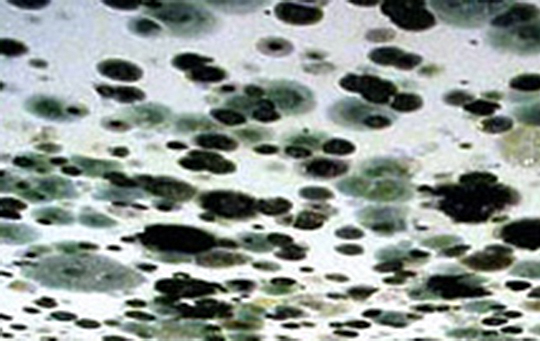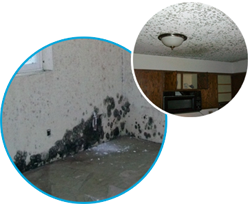Mold Inspections and Mold Assessments
Mold Inspections can either be performed directly by a restoration company or by a third party mold inspector. In a perfect world there is no difference as to who performs this, so long as the inspector is qualified to do so.
Recently, certain states have made regulations in the mold industry that prohibit performing a mold assessment and remediation on the same job. The reason for this is that there is a possible conflict of interest. The inspector should be unbiased and a restoration company has an incentive (getting a remediation job) to say there is a serious problem when there may not be.
Mold Testing
If you are doing your research on indoor mold growth, you have likely come across some information on mold testing. These tests can be performed by a mold inspector, before a job is started to:
Determine if a problem exist
Find a source of an issue
See what areas are
Air Samples:These mold tests are taken with a vacuum pump and a spore trap. The spore trap is basically a plastic cassette with a lab slide that has adhesive on it. The vacuum pump sucks air into the spore trap, and any mold spores in the air stick to the slide. These cassettes are sent in to a third-party laboratory, preferably one that is AIHA accredited, where they are opened and analyzed. The standard procedure is that an outside control sample is taken and compared to various inside air samples to see if abnormal or “elevated” conditions exist.
Surface Samples:Direct samples can be taken with a swab or tape lift when visible mold is present. This is helpful to the inspector because not all mold, including Stachybotrys, is easily airborne. It is very possible to have visible mold and not have an airborne mold problem, especially in water damage related mold growth that has recently started to colonize. These samples are used as proof for the inspector to make the correct recommendations and useful to help determine if the species is surface mold or deep rooted into a material.
The mold inspector will then take these lab results and make recommendations off of them along with what they saw on the visual inspection. Ultimately the inspector is performing mold tests to determine if:
There is a mold problem or not
What or where the source is
How far has the problem spread
What needs to be done in order to fix the issue.

Mold
Local boards of health (LBOH) may receive complaints about mold from housing occupants, or a LBOH inspector may identify mold during an inspection. The presence of mold can raise concerns about potential health issues and other effects. This training will provide an overview of mold, outline processes and procedures for LBOH to follow when investigating certain types of housing, and provide resources that can aid in resolving this complex public health issue.
After completing this training, you will be able to:
Explain what molds are
Name three things that spores need to grow into mold
Discuss three possible health impacts linked to indoor exposure to mold and one non-health impact of mold growth
Identify nine sections in 105 CMR 410.000 (410) that apply to mold, moisture, or water damage in certain types of housing
Respond to mold complaints in accordance with 410
List seven recommendations to prevent mold growth and eight tips to effectively clean up mold
What are Molds?
Molds are fungi that are part of the natural environment. Outdoors they break down dead organic matter. Indoors, however, they should be avoided.The key to avoiding indoor mold is to understand how molds grow and how to minimize the conditions that allow this growth.
Spores
Molds reproduce by making microscopic spores which can be released into the air. Spores float through outdoor and indoor air and can survive in harsh environments. Given the right conditions, spores will grow into mold relatively quickly, often in just 24-48 hours.
For spores to grow into mold, they need three things:
1. Food
Outdoor vegetation and building materials
Indoor materials, especially porous ones, such as paper, cardboard, ceiling tiles, wood, paint, carpet, and fabric
2. Moisture
Water leaks or flooding
Water vapor, the result of high relative humidity
3. Optimum Temperatures
40°-100°F (70°- 90°F ideal)
Mold can still survive in non-optimum temperatures

BASEMENT MOLD PREVENTION TIPS | CLEANFIRST RESTORATION
Mold requires nourishment, warmth, and moisture in order to grow. Unfortunately, your basement most likely has all three things, making it the perfect place for mold growth. Fortunately, there are ways to deal with basement mold growth
Four key steps in dealing with mold colonies are:
CONTAINING the basement mold and preventing it from spreading to other areas;
KILLING the basement mold;
REMOVING the dead mold; and
PROTECTING the cleaned out basement and adjacent areas against future mold colonies.
The fourth step, protection, is the most important and will be our focus here. As the old cliché goes, an ounce of prevention is better than a pound of cure. Preventing the growth of mold is ultimately cheaper and easier than trying to get rid of a mold colony. Also, focusing on protecting your home—your basement, especially—from mold growth will make sure you won’t have to deal with the first three steps.
Causes of mold growth in your basement
As mentioned earlier, a basement can be a breeding ground for mold because it can be damp and humid, with no exposure to sunlight. The usual cause of mold growth in basements is a water problem, such as flooding or leaky pipes. Condensation resulting from cold temperatures and high humidity is also another common cause of mold.
Detecting mold in your basement
You will need to detect mold so you can kill it and to ensure a thorough mold cleanup. The easiest way to check for mold is to sniff around for a musty or smell. The limited ventilation in your basement will make it much easier for you to detect any strange odors.
Mold Mycotoxins Indoor Pathogens
What We Do
sole focus is to help guide those with complex medical issues back to health through the environmental assessment of their homes and buildings. identify sources of mold, mycotoxins, and other indoor environmental pathogens, then create roadmaps for restoration and continued maintenance.
Team Approach
With the use of cutting edge video technology, field technicians live-stream your inspection to corporate headquarters, allowing to provide a comprehensive assessment performed by a team of multiple certified environmental consultants.
Progressive Sampling Methodologies
Combining comprehensive inspection process with the most progressive sampling methodologies available allows to gain a complete understanding of your unique situation. This enables us to provide a full roadmap for remediation and restoration.
About 10 years ago I had a mold exposure and I’m still suffering from very severe chronic issues, multiple chemical sensitivity, insomnia, anxiety, etc. I have the genetic predisposition to not be able to detox when I’m exposed to mold. Mold is a very serious thing that needs to be dealt with properly. I did work with another inspector years ago and he was not as thorough as We Inspect. It’s incredible, they will go through the inspection process as if they had a magnifying glass
I have a child with a congenital heart condition and it’s very important for her to have clean air. My daughter and I had been experiencing nose bleeds and memory loss that came on suddenly and we didn’t know why. I found mold underneath our kitchen cabinet and I felt it was important to get a professional mold inspector to see if my home was safe to live in. We Inspect are amazing mold experts. They were meticulous in their inspection process and did a very thorough job. They were really there for me and I really appreciated that. I would very highly recommend We Inspect for any mold testing. They are incredibly knowledgeable on the subjects of mold, mold testing, and remediation.
Mold Inspection And Testing – Qualified Mold Inspector
many realtors advise their clients to have black mold inspection and testing carried out before purchasing or selling a home. If mold is present in the home then this can be very bad for the deal. When selling a home, many sales are lost, and property values are reduced, due to the presence or smell of mold. The smell of mold causes many visitors to move on.
The value of a home can drop substantially if this happens enough, as many people will think something is wrong with it. When you sell your home it is always best to have a certificate from a mold company. After someone has signed a contract, mold is the last thing that they wish to find in the home
A Few Things You Should Know About a Mold Inspection and Testing
foreclosures have become an everyday part of modern life. When this happens the electricity is generally turned off which can create the perfect environment for the development of mold. The primary reason this happens is because the heating and cooling unit no longer works as a dehumidifier. If the humidity level inside your town is quite high, then not having a working heating and air conditioning unit could create the perfect conditions for mold to thrive.
You should also keep in mind that just like older homes on the market, new ones are now facing a greater threat of mold contamination. Energy efficiency is something that a lot of new house are good at maintaining. More development is actually more likely in these power-efficient homes due to the lack of airflow because of trying to save cash on power.
mold removal can be very costly. Your health could also be at risk if you don’t have it done. Even though all molds aren’t the toxic kind, all of them can cause allergies. It’s crucial to inspect the home you are considering purchasing doesn’t have toxic mold. This can quite easily be discovered through air quality testing. It is good practice to always have air quality testing in any real estate transaction to give you the peace of mind that you and your family are moving into a healthy, safe environment.